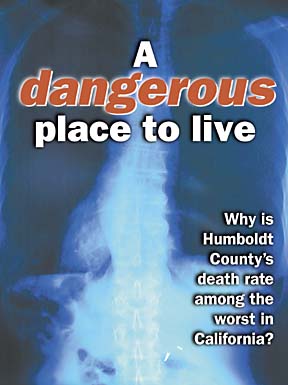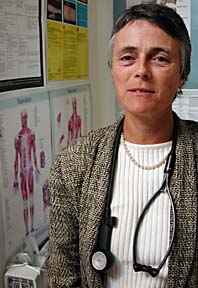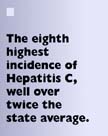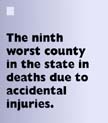|  

by ARNO HOLSCHUH See also SIDEBAR: More Than Looking Good - Dental care access in Humboldt County
HUMBOLDT COUNTY IS A DANGEROUS PLACE TO LIVE. It may not seem that way -- our idyllic forests, beaches and Victorian facades hardly seem likely to harbor life-threatening menaces. But all this bucolic beauty is misleading: We have the fourth-worst death rate of all 58 counties in California. What does that mean? On average, 1,158 of Humboldt County's roughly 126,000 citizens die every year. Death rates are measured as deaths per 100,000 population; Humboldt's death rate is 942. By comparison, Mono County's is 496. We even make big cities look safe: San Francisco County's death rate is 720 and Los Angeles is  791. 791. But death is part of life, and Humboldt County can hardly be faulted when people within its borders become so old that they simply expire -- right? Wrong. "It's an age-adjusted death rate, so you can't just say it's because we have older people," said Dr. Ann Lindsay, Humboldt County's public health officer.
 It is Dr. Ann Lindsay's job to find out why our It is Dr. Ann Lindsay's job to find out why our
death rate is so high and try to do something about it.
It is Lindsay's job to find out why our death rate is so high and try to do something about it. One of her guides in that task is the County Health Status Profile, an annual report published by the state Department of Health Services. The profile lists the mortality rates for several major causes of death and incidence rates for some of the most common and serious diseases. What it has to say about us is grim: Out of 58 counties, the county ranks 13th in deaths due to diabetes, 12th in both homicides and suicides, and fifth in cancer deaths. People living in Humboldt are more likely to die because of a firearm-related death than those who live in Los Angeles. Some of those statistics are hard to address, Lindsay said. The causes of the high cancer rate, for example, are unclear. No one cancer sticks out as being the culprit. Firearm deaths are related to the gun culture in Humboldt County and many other rural areas of California. But several of Humboldt County's worst health problems are at the nexus of two classic vices --and drugs. Susan Riesel's job is not always an easy one. As a physician's assistant and the facilitator of the teen clinic at Arcata's Open Door Clinic, it is her job to inform her clients -- mostly teenage girls -- that they have contracted chlamydia. "Often when it's a teenager, and that is the most common thing, they cry," Riesel said. "They're shocked. I just had to tell one today." It is a frequent occurrence. Humboldt County has the state's fourth-worst infection rates for chlamydia. If left untreated, the disease can cause infertility or chronic pelvic pain. "It's common in our community and the teen population," Riesel said. The disease is extremely easy to transmit -- "especially if you aren't using a condom" -- and not all people do. Compounding the problem is the sometimes volatile nature of teenage love.
![[photo of Susan Reisel]](cover1004-Riesel.jpg) "They come in and sit in that chair and I have to tell them they have chlamydia." "They come in and sit in that chair and I have to tell them they have chlamydia."
-- Susan Riesel, Arcata Open Door Clinic physicians' assistant and facilitator of the teen clinic
"Part of it is a teen population that is sexually active and serially monogamous," said Deborah Sweitzer, a physicians' assistant at Arcata's North Country Clinic. Sweitzer, like Riesel, helps people deal with the consequences of their decisions about sexual practices. She said she sees some teens changing boyfriends or girlfriends at a rapid pace. "The kids are in an exploring part of life and changing partners more frequently is a part of some teens' lifestyles," she said. As alarming as sexual activity among teens and the resulting chlamydia infections may be, Schweitzer said there is a good public health mechanism in place to deal with the problem. "We treat the patient and then treat their partner," she said. The treatment, a single dose of antibiotic, can be sent home with an infected individual so that their partner doesn't even need to come to the clinic. There's even a delivery service of sorts. "If the patient doesn't want to deal with their partner themselves, sometimes the county's Department of Public Health will find them and administer the treatment," Sweitzer said. But there's a hitch. Treating the patient and the partner works fine unless you don't know who the partner is -- and that is sometimes the case. "I think there are men, 20- to 25-year-olds, who are predatory," Riesel said. When teenage women become infected by such a man, the public health system faces an unusually difficult task: Treating him to stop the spread of chlamydia can be next to impossible. "I don't know who they are and often these girls don't even know their last names," she said. If you can't find him, you can't treat him, and he will likely spread the disease further. But even in that case, chlamydia isn't Humboldt's biggest worry. While the disease is widespread and highly infectious, it is also easily treatable and nonfatal. What is more troubling are the underlying habits that have permitted its spread: Unprotected sex with more than one partner.  Those habits can expose individuals to a much more serious disease: HIV. The incidence of HIV isn't reported and published like that of chlamydia or syphilis, so there's no way to know how many people in Humboldt County carry the disease. Those habits can expose individuals to a much more serious disease: HIV. The incidence of HIV isn't reported and published like that of chlamydia or syphilis, so there's no way to know how many people in Humboldt County carry the disease.
"We assume that number is relatively low," said Lindsay. As long as the baseline rate of infection stays low, the disease will have a harder time spreading: If only 1 percent of the population is HIV positive, you only run a one in 100 risk of exposure when having unprotected sex. And living behind the Redwood Curtain has probably helped keep the baseline low. "Isolation has something to do with it," Lindsay said, but with increased migration and travel, "that can change at any time." If and when it does, Humboldt County is likely to be in trouble. Not just because of sex, but also because of the other main avenue of HIV infection: intravenous drug users. "In 1996 we did a `seral prevalence' study," Lindsay said. That means the county paid former intravenous drug users who still knew the network to go out and find people currently using. They took blood samples which were tested for diseases. The results were sobering: Almost three quarters of those tested had Hepatitis C, an often incurable virus that attacks the liver. Current statistics from the health profile confirm those results. Humboldt County has the eighth-highest incidence of the disease in California, well over twice the state average. It's a serious problem: Hepatitis C is extremely infectious, expensive and difficult to treat and can lead to serious complications. Coupled with alcohol abuse, as it often is, it can cause liver failure and death. But there's only one way to catch it. "Hep C is rarely transmitted sexually; it's pretty much just through blood to blood contact," Lindsay said. The conclusion: The population of people who shoot up in Humboldt County is sharing needles. Aside from the harm caused by Hep C itself, the data on infection rates has ramifications similar to those of a widespread chlamydia. "It indicated to me that even though we had a small number of HIV-positive people, the habits that transmit that disease exist in our community."  The county has responded to the data on Hepatitis C and intravenous drug use: The needle-exchange program, instituted in January 2000, is designed to provide users with clean equipment so that those who use will at least not spread disease. The county has responded to the data on Hepatitis C and intravenous drug use: The needle-exchange program, instituted in January 2000, is designed to provide users with clean equipment so that those who use will at least not spread disease.
But drug use in Humboldt County is a much bigger problem than just shared needles. Of all the statistics in the Health Profile, the most damning is the drug-related death rate: We are the No. 2 county in the state in drug-related deaths, behind only Yuba County. It is a comprehensive problem. Most alcohol or other drug-related deaths aren't overdoses; they are deaths in which mind-altering substances played a deciding role. Alcohol and other drugs are behind many of Humboldt County's other health problems identified in the report. "They are a common theme through all of this," Lindsay said. Hep C is caused by intravenous drug use; poor choices about sexual practices may be influenced by alcohol; and drugs are often involved in homicides and suicides. Nowhere is the relationship between drugs and other health issues so clearly demonstrated as with methamphetamines and accidents.  Last year a group of businesses from around the county -- mills, casinos, hotels, construction companies and restaurants -- took part in a study. The businesses, which employ a total of 1,100 people, all conduct pre-employment drug screening to prevent drug use on the job. But when they performed drug tests on the 20 people who had had accidents on the job, 80 percent were found to have been using methamphetamines. Last year a group of businesses from around the county -- mills, casinos, hotels, construction companies and restaurants -- took part in a study. The businesses, which employ a total of 1,100 people, all conduct pre-employment drug screening to prevent drug use on the job. But when they performed drug tests on the 20 people who had had accidents on the job, 80 percent were found to have been using methamphetamines.
If it had been marijuana found in those accident victims, one could reasonably speculate it was a coincidence -- marijuana stays in the body for weeks after use, so a Thursday accident victim could have smoked a joint on the weekend and still test positive. But unlike marijuana, meth quickly exits the body after use: The accident victims all had to have used meth in the 72 hours before the accident. The result? Humboldt County's rate of deaths due to accidental injuries is the ninth worst in the state. As serious as the drug problem in Humboldt County is, it is not insurmountable. Some companies, for example, have been instituting employee drug-treatment programs. At Pacific Lumber Co., a policy has been instituted where workers can check themselves into drug treatment without worrying about getting fired. Since that policy has been put in place, accident injuries are down. For Lindsay, such results indicate that you can have a positive effect on public heath. You may not be able to make Humboldt County safe -- our roads will always be curvy and often slick, and fishing and logging will always be dangerous occupations. But through efforts like the needle exchange, treating sexually transmitted diseases or improving access to drug treatment, you can make a difference. "If people are dying prematurely, it's part of our vision to deal with it."
 by Arno Holschuh by Arno Holschuh
DENTAL CARE MAKES IT HARDER for kids to get good nutrition and speak correctly. They get sick more easily. Kids have trouble getting jobs later if they don't have good teeth. There are even some problems with heart disease that have been linked to dental care," said Ann Lindsay, Humboldt County's public health officer. "It's not just a cosmetic issue." As important as healthy teeth are, Humboldt County is not doing a very good job. Untreated tooth decay is the most common childhood disease here and we are woefully unprepared to fight it. Studies show that between 26 and 39 percent of our children have unmet dental needs. In one isolated community, that number rose to 85 percent -- with an average of five teeth needing treatment in each child. Some kids are so bad off that they require hospitalization -- and there's a waiting list of 25 children for those extreme cases. "It's the No. 1 unaddressed problem for children in our community," said Dr. Rebecca Stauffer, a deputy public health officer for the county. Stauffer, as a member of the Children's Dental Health Task Force, has been looking for ways to address the lack of quality dental care. "It's a complicated situation. There are a number of different reasons why we have gotten into the position," she said. Part of the problem is that the public insurance plans for low-income families, DentaCal or the Healthy Families program, are not as lucrative as private plans. That means dentists are less likely to provide care to low-income individuals. And in Humboldt County, dentists can afford to pick who they want to treat. There are fewer dentists per capita here than in urban areas, and that makes it even harder for poor kids to get dental care, Stauffer said. "Because there are more dentists in urban areas, there is more competition and they are forced to take DentaCal and Healthy Families. Up here in Humboldt, there isn't that incentive, so most public insurance clients are seen in clinics" -- and there aren't enough clinic treatment slots to go around. It's led to a situation where dental care has become a privilege of the middle class and above: Children from families earning less than $20,000 annually are 10 times more likely to have unmet dental care needs than kids whose families earn $50,000 a year or more. That's why one of Stauffer's priorities is to get more dentists up to Humboldt County. She may be receiving some help from Sacramento. A bill awaiting the signature of the governor would make it easier for out-of-state dentists to relocate to rural California. The bill is, however, not going to solve the problem alone. "We don't have a long-term solution to the treatment access problem," Stauffer said. Other possible ways of mitigating the dental care crisis include improved nutrition in school lunches, a media campaign to highlight the importance of dental care and fluoridation of the municipal water supply. That last measure is seen by public health workers as the most effective and economical of all, but there are difficulties. While Arcata, Eureka and Scotia already fluoridate, the push to add the mineral to the drinking water supply has met stiff resistance in rural Willow Creek. (See the Journal's In the News report, Oct. 26, 2000). But given the state of dental care in Humboldt County, implementing prevention-based measures like fluoridation is becoming more and more pressing. "This disease is completely preventable using well-known low-tech interventions," Stauffer said. "With good oral hygiene and good nutrition, you can not even need to see a dentist and could avoid even worrying about insurance."
IN THE NEWS | ARTS ALIVE! | CALENDAR Comments? E-mail the Journal: [email protected] 
© Copyright 2001, North Coast Journal, Inc. |